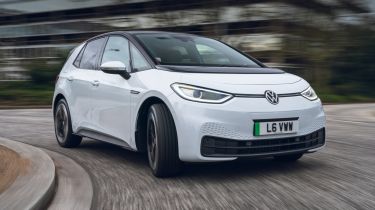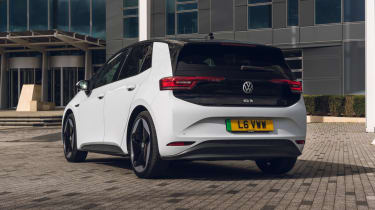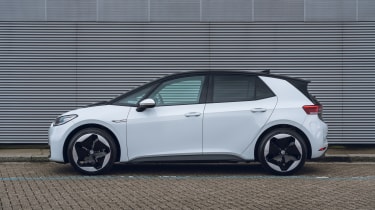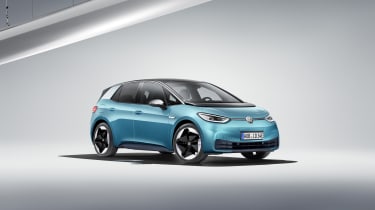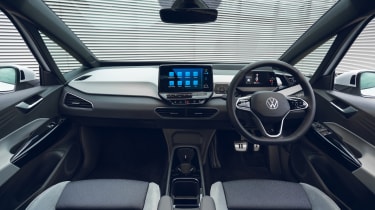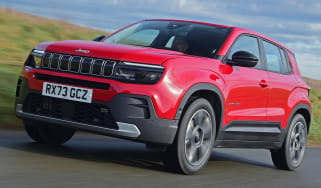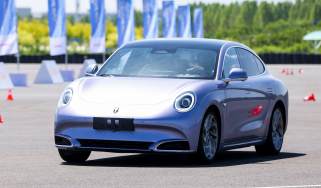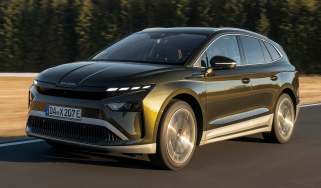2021 Volkswagen ID.3: new Pure Performance model joins range
The ID.3 Pure Performance has a price of £28,370 and a range of up to 217 miles
- New Pure Performance model has 148bhp
- Prices start from £28,370 after the plug-in car grant deduction
- Four powertrains now available across the ID.3 range
A new ‘Pure Performance’ version of the Volkswagen ID.3 has been introduced to the range, alongside a new entry-level ‘City’ trim level. The Pure Performance model has a less powerful, 148bhp electric motor, and a smaller and lighter 48kWh battery that returns a range of up to 217 miles. It’s available to order now with prices starting from £28,370 after the government’s plug-in car grant deduction.
 The 10 best electric cars in 2025
The 10 best electric cars in 2025
The new Pure Performance powertrain slots in between the entry-level ‘Pro’ model and the ‘Pro Performance’ powertrain, which use a 58kWh battery. The ID.3 ‘Pro S’ features the largest battery in the range, at 77kWh.
2021 Volkswagen ID.3: performance, range and charging
The Pure Performance model boasts a 48kWh battery and is capable of up to 217 miles on a charge. Topping up the battery from 5% to 80% takes just over half an hour using a fast charger. A full charge via a 7.2kW home wallbox takes seven and a half hours. Its power output of 148bhp places it in the middle of the ID.3 range. The car can do 0-62mph in 8.9 seconds.
The existing Pro model has a reduced power output of 143bhp, resulting in 0-62mph in 9.6 seconds. In Pro Performance guise, power is increased to 201bhp, making it the quickest ID.3 currently available, with a 0-62mph time of 7.3 seconds.
Both the Pro and Pro Performance models get a larger 58kWh battery, giving a range of between 258 to 263 miles. When connected to a 100kW fast charger, the battery can be charged from 5% to 80% in around 35 minutes. A full charge via a 7.2kW home wallbox takes around 9.5 hours.
The flagship Pro S version is powered by the same 201bhp rear-mounted motor but features a 77kWh battery. It manages 0-62mph in 7.9 seconds, and is officially capable of up to 336 miles of range on a charge. The battery can be replenished from 5% to 80% in 38 minutes using a 100kW fast charger. Using a home wallbox, a full charge at 7.2kW takes around 13 hours.
Volkswagen is aiming to make all ID.3s carbon-neutral, offsetting production emissions with currently unnamed climate projects. The company is also forging partnerships with UK companies to provide chargers at hundreds of locations, including plans to add 600 charging points at Tesco stores around the UK.
You save roughly £1,000 by choosing the less powerful motor, although the difference may not be huge on a PCP finance deal. The Pro and Pro Performance models look like good value when you consider they only cost around £2,000 more than a Honda e or Vauxhall Corsa-e, both of which are much smaller and offer less range.
Volkswagen ID.3 UK prices, specifications and equipment packs
| Trim level | Price (PiCG limited to £35,000) | Packs fitted |
| City | £28,370 (after PiCG) | Infotainment, Comfort |
| Life | £29,970 (after PiCG) | Infotainment, Comfort |
| Business | £35,710 | Infotainment, Comfort, Design, Assistance |
| Style | £32,470 (after PiCG) | Infotainment, Comfort, Design Plus |
| Family | £36,640 | Infotainment, Comfort Plus, Design Plus, Assistance |
| Tech | £39,500 | Infotainment Plus, Comfort, Design Plus, Assistance Plus |
| Max | £41,530 | All 'Plus' packs + Sport |
| Tour | £42,600 | Infotainment Plus, Comfort Plus, Design, Assistance Plus |
The ID.3 has been positioned as an easy and comfortable way to make the switch to an electric car but its hierarchy of eight trim levels is a little complicated. Most equipment is bundled into packs, such as Comfort and Infotainment, with a ‘Plus’ version of each. But even the cheapest car gets LED headlights, adaptive cruise control, keyless start, 18-inch alloy wheels and parking sensors all-round.
 New Volkswagen ID.3 vs Tesla Model 3: rivals comparison
New Volkswagen ID.3 vs Tesla Model 3: rivals comparison
‘Infotainment’ appears on every model and includes a 10-inch sat nav touchscreen, dual Bluetooth connectivity, DAB radio and two USB-C ports, while Plus adds an upgraded audio system and an augmented reality head-up display. ‘Comfort’ means you get auto wipers, rear USB sockets, heated seats, a heated steering wheel and folding mirrors; Plus brings two-zone climate control and a variable-height boot floor.
Cars with the ‘Design’ pack get matrix LED headlights, ambient lighting, an illuminated headlight strip and tinted windows, while Design Plus cars also feature a large panoramic sunroof. The Assistance pack includes a rear-view camera, keyless entry and illuminating door handles, to which you can add extra safety equipment - including VW’s Travel Assist system - with the Assistance Plus pack.
’Sport’ includes sports suspension and a Plus version with dynamic chassis control is coming later.
Volkswagen ID.3 1ST Edition
At launch, the ID.3 was only available in a limited production 1st Edition trim. This model was equipped with the 58kWh battery, giving it a range of around 260 miles. Fast-charging capability featured as standard and buyers received a year’s free charging at compatible charging points.
Rivals and styling
The Volkswagen ID.3 rivals the Hyundai Kona Electric, Kia e-Niro and Nissan Leaf.
Volkswagen has managed to make the styling similar to its petrol and diesel-powered cars but with a futuristic touch. The ID.3 is almost the same size as a Volkswagen Golf but has a much stubbier bonnet. The front and rear lights are LED units, while its sleek shape, roof spoiler and fared-in alloy wheels will help aerodynamics and range. Most cars are likely to have a gloss black tailgate and roof, and the concept’s sliding doors have been replaced with conventional versions. The production car is very slightly bigger than the original concept, due to extra pedestrian safety requirements.
Interior and technology
With batteries under the floor and no conventional engine, the ID.3 offers a surprising amount of space. Despite appearances, four adults will have plenty of room - about as much as you’d get in the larger Volkswagen Passat.
The ID.3 also features autonomous technology more prominently than any current VW, with sensors all around the vehicle and multiple cameras. Volkswagen will showcase a new kind of ‘augmented reality’ head-up display, which presents navigation information about the world around you on the windscreen, including which street you need to turn down.
Once it’s been in production for five or so years, VW expects to roll out full ‘Level 5’ autonomy, which will allow the ID.3 to take its occupants from door to door with no driver input. Selecting autonomous mode could even see the car’s headlights feature dynamic patterns that can beckon other vehicles and pedestrians across its path.
What does it mean for car buyers?
The ID.3 has been billed as one of the most important cars in VW’s history, following in the footsteps of the Beetle and Golf. A confusing trim level line-up and a couple of features not ready for the car’s launch suggest the ID.3’s release may have suffered some disruption. Still, now the car is on sale it should be popular because it brings the familiarity of a Golf with a decent electric range and a hi-tech interior. At the moment, the cheaper trim levels seem to offer the best value-for-money.
Take a look at our Nissan Leaf review or check out our picks for the best electric cars you can buy now.
Recommended
Most Popular
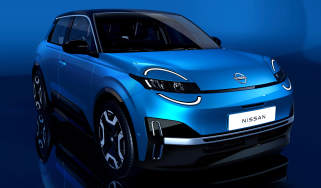
New Nissan Micra is a Renault 5 in Nissan clothing
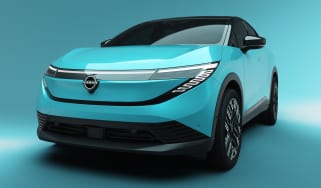
New Nissan Leaf is here! Groundbreaking EV has morphed into an SUV
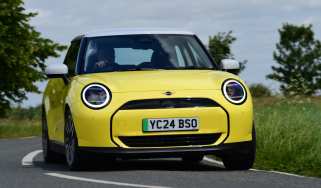
Best car leasing deals 2025: this week’s top PCH offers
Tips & advice

Car dashboard warning lights: what does each symbol mean?

Electric car charging stations: public networks, charger types, apps and maps


